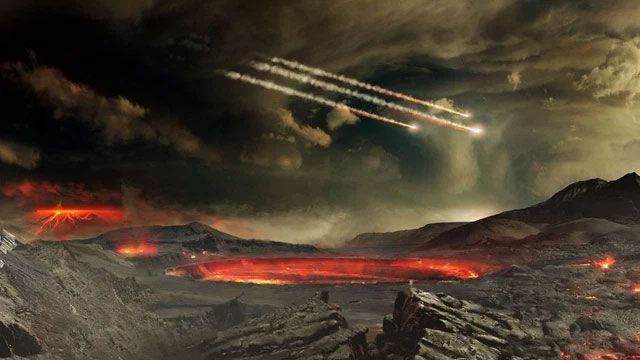A spoonful of carbon, a drop of hydrogen, and a pinch of cyanide – this could be a code for the recipe that creates the basic building blocks of life. Yes, you read that right: The extremely toxic chemical cyanide.
Throughout history, cyanide has rightly been regarded as an extremely toxic substance. It has been used as a biological weapon since the Franco-Prussian War in the late 1800s, through both World Wars, and there is some evidence supporting its role in the Iran-Iraq War. It has even permeated popular culture, appearing in famous movies and comics, often used by spies or those contemplating the choice between betrayal and death.

Cyanide is quite common in popular culture, especially in comics.
However, in a recent article published in the journal Nature, a group of chemists suggests that although cyanide often ends life as we know it, it may have helped develop life from the primordial times of Earth, around 4 billion years ago. Back then, the world looked very different than it does now. For instance, the oxygen we breathe did not yet exist.
“Cyanide is toxic to the biological mechanisms we study today,” said Ramanarayan Krishnamurthy, a chemist at the Scripps Research Institute in California and the lead author of the study. “But it may not be toxic if nature knows how to handle it.”
In the laboratory, he and his researchers essentially mixed together a series of molecules present on primordial Earth and then added a bit of cyanide.
Ironically, this dangerous substance helped synthesize the simplest components of life – under moderate reaction conditions and relatively few steps. Everything was surprisingly simple.
“That sometimes makes you feel scared when it’s too simple,” Krishnamurthy said. “We checked this with three or four different people to ensure we had accurate interpretations.”
The research team noted that its unique mechanism marks the “first demonstration” of this type of biological pathway leading to the origin of life – and a mechanism that is much simpler than its widely accepted non-toxic counterpart, which requires harsh reaction conditions, complex steps, and trust.
What really happened 4 billion years ago?

We cannot know what happened in primordial times, but…
For a long time, experts have believed that in the primordial oceans of Earth was a “primordial soup,” containing a mixture of various molecules continuously swirling together. And this “elemental stew” forced molecules to interact and form complex compounds, which then mixed, and after many steps, gave rise to simple organisms. This process eventually produced everything, including us.
A key feature in this story is the reduced tricarboxylic acid cycle, or r-TCA cycle. This eight-step biological process uses proteins to form compounds that sustain life. In short, it is considered essential for life today, so experts believe it was likely important for life long ago and has since disappeared into the primordial soup.
But the problem is that the early environment of Earth was not ideal for r-TCA. Oxygen was absent when Earth was still too young, and neither were the proteins that drive the cycle. Scientists often say that certain metals could make everything happen, but that requires harsh conditions, such as extremely high temperatures.
Chemist Krishnamurthy explains that many of those conditions not only existed on primordial Earth but also hindered scientists from gradually mimicking the ancient r-TCA in the laboratory. Chemists had to piece everything together, apply conditions, wait, and observe.
While such experiments produced r-TCA compounds, it was very difficult to prove that they actually originated from the cycle. Essentially, it is unclear whether r-TCA truly occurred 4 billion years ago.
In an effort to demonstrate an alternative reduced cycle that produces compounds initiating life, Krishnamurthy conducted experiments with cyanide instead of troublesome metals. Notably, he found that molecules followed a similar pathway to r-TCA, step by step, but with fewer overall stages and in much gentler conditions.
It seems to tell the story of early Earth life in a significantly easier way.
Nonetheless, researchers are considering their results with a grain of salt. Krishnamurthy said: “Cyanide is believed to have been present on primordial Earth, although there is no direct evidence of that because it is a reactive molecule that may have been consumed.”

According to chemist Krishnamurthy, let’s stop assuming biology and just see how everything was created in many ways.
Krishnamurthy also draws an analogy for interpreting this concept.
Imagine bringing someone from a distant village, who only knows how to build houses with bricks and a few builders, to New York City. They would be amazed looking up at the skyscrapers and might ask you how these metal towers could be created.
Of course, what they do not know is that these skyscrapers are not made of bricks and certainly not by a small group of construction workers. They are made of steel, using cranes and massive equipment.
“What we are looking at in biology is this huge, beautiful building,” Krishnamurthy said. “But we don’t know how it was built and what came before it that allowed it to happen.”
According to him, if there was enough cyanide on primordial Earth, life likely owes its existence to what we now accept as a poison. And taking it a step further, if extraterrestrial life exists on other planets, perhaps cyanide has also “had a hand in it.”
“We want chemistry to tell us how everything happened,” Krishnamurthy said. “Instead of assuming that we know how biological processes occurred 4 billion years ago. No, clearly we know nothing about that time.”


















































